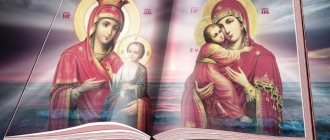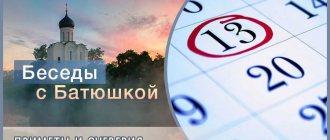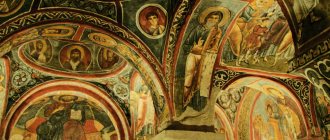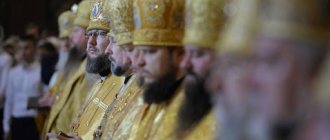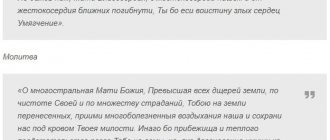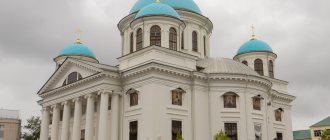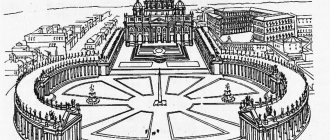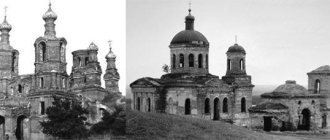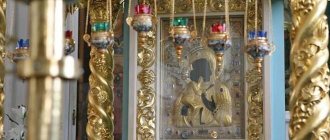There are many challenges along the path of life. In front of the icon of the Most Holy Theotokos, people pray for the protection of family and friends, for help in a difficult situation, for things that cannot be solved either with money or with the mind. According to art historians, there are about 700 variants of the holy image of the Blessed Virgin in the world, and their classification has even been developed. This is why the Mother of God is depicted in different ways.
Traditional writing of the icon of the Virgin Mary
According to church historians Nicephorus Callistus and monk Epiphanius, there are about two and a half hundred icons of the Mother of God. However, there are main traditions in the painting of classical icons of the Virgin Mary. Including the obligatory presence of a maforia - a married woman's bedspread, and a tunic - a long blue dress. Maforia are usually decorated with stars. The most striking example of such icons is Oranta.
A variety of such classical icons are also the “Inexhaustible Chalice”, the Vladimir Icon of the Mother of God, Eleusa or Tenderness, Pochaevskaya.
There is also another common type of icon of the Mother of God - Hodegetria. These include, for example, Kazan, All-Merciful, All-Tsaritsa.
The next type of icon with the Mother of God is Agiosoritissa. In them, the Virgin Mary is turned to the side in prayer. Such icons include, for example, Bogolyubskaya.
This is only a small part of the icons of the Mother of God; there are actually a huge number of them. You should not get lost and pray to the icons that you have. The main thing is to believe in your soul in their strength and sincerely desire to be cleansed spiritually and morally.
Kazanskaya
It is believed that Our Lady of Kazan protects from enemies and heals ailments.
Those who are in trouble can ask her for help and protection. This icon can be placed at home or given as a gift. This image belongs to the “Hodegetria” type, that is, its goal is to direct a person to the true path.
Icon of Kazan
Story
In the 16th century there was a fire in Kazan. The holy face was discovered by the merchant's little daughter Matrona. In a dream, the Mother of God appeared to her and told her to get the icon from the fire. Surprisingly, the image was not damaged and looked new. A convent was built at the site where the icon was discovered. The icon was given to the Assumption Cathedral for storage. However, in the 20th century the icon was stolen and then destroyed. Only copies of the image have survived. After the founding of the temple, Matrona and her mother became abbess.
Celebration dates
It is customary to celebrate this image twice a year:
- 21st of June. On this day, the girl saw a vision of the Virgin Mary. Celebrated since the 16th century;
- November 4. Moscow was liberated by Minin and Pozharsky in the fall of 1612.
Before the decisive battle, people prayed and asked for intercession. After the revolution, November 4 ceased to be a holiday; in 2005 it became the Day of National Unity. The same service is held on these days.
Icon location
In the early years it was located in the Tretyakov Gallery. A copy of it is kept in the home church of the Moscow Patriarch. This copy is a gift to the Roman Catholic Church in honor of the end of the rivalry between the churches. The closest copy to the original is kept in the Prince Vladimir Cathedral in St. Petersburg.
Meaning
The Kazan Mother of God helps people realize and find their true path through life.
They prayed to her during the Time of Troubles, and thanks to her protection, troops recaptured Moscow from the Polish invaders. Peter I prayed to her before the Battle of Poltava. During the Patriotic War of 1812, she helped soldiers win several victories. Kutuzov prayed to the Mother of God before heading into the army.
Miracles that happened during religious processions are associated with it:
- The unknown pilgrim was cured of his illness;
- The daughter-in-law of a noble man got rid of a leg disease;
- The newborn received his sight;
- Demons came out of several women.
After this, all the sufferers hurried to the icon.
Not only military or political figures, but also ordinary people can rely on the protection of the Kazan Mother of God. If you ask from a pure heart, then she grants her protection to everyone who asks.
Some needlewomen embroider icons with beads
How does it help?
The Kazan Mother of God helps everyone who believes and asks for help:
- They ask the Kazan Mother of God to bless the marriage of the young;
- Married couples turn to her with a request to find harmony in their relationships and get rid of unhappiness.
- Most of all, she is supportive of children: she protects them from misfortune, evil people and helps them on the path of life;
- They pray to her to help the soldiers and protect their native land;
- It helps you find the right solution and avoid failure. Witnesses say that she came to them in their dreams and told them what to do and how to do it, and what to give up. Thus, a person avoids trouble;
- They pray to her in difficult times, when there is not enough strength to fight. In sorrow, she will comfort the one who asks and give him instructions;
- It helps with weakening faith in the soul and cures ailments. They ask her to get her sight back. Helps you to see spiritually.
How to pray
In order for the Kazan Mother of God to hear the request, you need to pray to her correctly. You can pray at home and in church. If you decide to do this at home, it is best in the morning:
- After waking up, you need to wash your face with cool water, cross yourself and tune in to a positive mood, throw away all the negativity that lurks in your soul;
- Calm down, there should be no unnecessary thoughts in your head;
- It doesn’t matter how long the prayer is, the main thing is that it comes from a pure heart;
- After prayer, you can begin your petition. It will not be heard if it contains a negative wish.
Data
A few facts about the Kazan Mother of God that may be interesting:
- The original icon was small in size - approximately 26x22 centimeters;
- There were two vestments - for the holidays and for everyday use. The festive one was made of gold, and on top was a frame with precious stones. Casual made of pearls;
- Most often they ask her for relief from eye ailments, attacks, or help in difficult times;
- In honor of the Kazan Mother of God, the Kazan Cathedral was erected at the expense of Pozharsky;
- In the 17th century, the icon became a state-level shrine;
- The first set of jewelry was ordered to be made by Empress Anna Ioannovna. She ordered to build a church and move the icon there;
- A cathedral was built in her honor in St. Petersburg;
- During the terrorist attack in the Winter Palace, the icon was not damaged, although the room where it was located was completely destroyed;
- The icon is credited with helping to win the Great Patriotic War. They say that Zhukov himself took her to the front;
- The most famous Kazan icons are: the Moscow/St. Petersburg lists and the revealed icon. However, the Moscow list and the revealed icon were lost;
- At the beginning of the 20th century, the revealed icon was stolen, later burnt icons were found in the thief’s oven, presumably it was also destroyed;
- There is a legend that the abbess of the monastery changed the icon for an exact copy before going to bed in order to protect the shrine from thieves. Therefore, it is believed that the real icon was not stolen;
- The list of Moscow was stolen at the beginning of the last century, where it is now is unknown;
- The St. Petersburg list survived because the abbot told the Bolsheviks that the list had no value;
- One of the lists was taken out of Russia to save it from the Bolsheviks. Kept by the Pope, many years later the list returned to Kazan;
- This icon is considered a wedding icon;
- The list of icons went to the ISS in 2011;
- Monasteries and churches are dedicated to her not only in Russia, but also in Belarus, Finland and Cuba.
VIDEO: Intercessor. Kazan Icon of the Blessed Virgin Mary
Intercessor / Kazan Icon of the Blessed Virgin Mary
In the center of the plot of the film is the Vatican list of the Kazan Icon of the Mother of God - the main Orthodox shrine of Kazan.
What do they pray for in front of the icons of the Mother of God?
Interestingly, in fact, the Russian Orthodox Church created and honors 260 of the most famous icons of the Mother of God. At the same time, they claim that there are even more of them - about 900. Each of these icons is dedicated to a specific event in the life of the Virgin Mary. Having a certain problem or concern, people choose a “suitable” icon. For example, about the preservation of family well-being, reconciliation, assistance in childbirth, the success of children and the health of the defenders of the Fatherland, they turn to the Vladimir image of the Mother of God.
The image of the Mother of God “Inexhaustible Chalice” is “responsible” for getting rid of drunkenness and drug addiction, before which they also pray for successful transactions related to real estate.
For the condemned, forgiveness of the sin of abortion and healing from malignant neoplasms, they ask for the icon “Joy to All Who Sorrow.”
“Iverskaya” is asked for a spouse to return to the family, as well as for a new addition to the family.
The icon of students and schoolchildren is the image of the Mother of God “Addition of Mind”.
In order to find their soul mate, to create a happy and strong family, they ask for the “Protection” icon of the Blessed Virgin Mary.
For women's health and well-being, for beauty and youth, you can ask the icon of the Mother of God “Unfading Color”.
News source
Icon of the Nativity of the Mother of God
Photo: Nativity of the Mother of God with selected saints (from left to right: Great Martyr Dmitry of Thessalonica, Saint Nicholas, Prophet Elijah, Great Martyr George), late 14th century, Novgorod North. State Tretyakov Gallery Nativity of the Mother of God with selected saints (from left to right: Great Martyr Dmitry of Thessaloniki, Saint Nicholas, Prophet Elijah, Great Martyr George), late 14th century, Novgorod North.
State Tretyakov Gallery The general principle of writing any Christmas is to congratulate the mother who gave birth. “The tradition of this generally accepted design goes back to pre-Christian iconography, depicting a lying woman in labor, whom everyone congratulates and brings gifts to her,” says the art critic. There is one scheme, but it has many options. For example, this not the most elegant Novgorod icon is distinguished, according to Alexander Kopirovsky, by a rather rare plot. The saints in the upper field, who seem to be present at the birth of the Virgin Mary, are from very different times: the prophet Elijah lived long before the Nativity of the Virgin Mary, and all the other saints - much later than her earthly journey ended. Everything has shifted in time.
The icon of the Nativity of the Mother of God is no longer about Her herself, but about her parents, first of all, about her mother, Saint Anna. In this icon she is very impressive, imperious, strict, she seems to not experience suffering and pain after childbirth. In contrast to her huge figure, newborn Maria looks very small, tiny. But the very fact of Her birth is of great importance for the whole world. After all, this is the guarantee of future salvation. She is born who will become the mother of the Savior.
“Many women in Judea dreamed that the Redeemer would be born from them. Those who were directly or indirectly among the descendants of King David especially hoped for this, says the theologian. – The Virgin Mary was also one of the descendants of David. And this contrast is shown very clearly in the icon: not a majestic queen is born, but a small creature is born, and she is held in the arms of a midwife. That is, She is born like everyone else.”
Although, according to the art historian, there are also icons of the Nativity of the Virgin Mary in which She is likened to a queen, to whom many virgins in expensive clothes bring luxurious gifts. Icons of the Nativity of the Virgin Mary can be surprisingly different, it all depends on the chosen accents. For example, it may be emphasized that this is a miraculous birth that the parents did not hope for. After all, the parents of the Virgin Mary, Anna and Joachim, were very old by that time. And there are ancient icons, from the end of the 15th century, where Anna even puts her left hand on her bosom - as if she is still in pain, and she bows her head, not sitting as majestically as here on the icon. Completely different accents are possible.
In the iconography of the Nativity, the Mother of God herself is almost absent; Her image is only slightly indicated - and this is already a guarantee of the entire future development of humanity, says Kopirovsky.
Subjects of the Mother of God icons
In iconography there are a great many different icons that depict the Queen of Heaven. “There are those in which She is depicted in scenes from the New Testament,” says Alexander Kopirovsky. – An angel preaches to her the future birth of Jesus Christ (Annunciation). She is depicted in the scene of the bringing of the infant Christ to the temple (Candlemas). She is in front of the crucifix. Or She is in subjects related to the triumph of Her icons or posthumous events, for example, the Intercession of the Virgin Mary. She is also majestic, She is also mournful, She is also soft - there are a lot of icons of the Mother of God. But the greatest variety of icons of the Mother of God is where She is together with the Infant Christ.”
According to the art critic, the entire iconography of the Mother of God, where she is depicted with the Child, develops around three writing options: either the Virgin Mary and the Child press their cheeks to each other, or She sits upright and regal, or the Child is depicted in her womb, inside, but how as if at the same time in front of Her.

